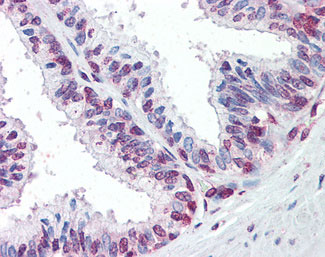ZIC3 Antibody (aa178-189)
Goat Polyclonal Antibody
- SPECIFICATION
- CITATIONS
- PROTOCOLS
- BACKGROUND

Application
| IHC-P, E |
|---|---|
| Primary Accession | O60481 |
| Reactivity | Human, Mouse, Rat, Rabbit, Monkey, Horse, Bovine, Guinea Pig, Dog |
| Host | Goat |
| Clonality | Polyclonal |
| Calculated MW | 51kDa |
| Dilution | ELISA (1:64000), IHC-P (5 µg/ml), |
| Gene ID | 7547 |
|---|---|
| Other Names | Zinc finger protein ZIC 3, Zinc finger protein 203, Zinc finger protein of the cerebellum 3, ZIC3, ZNF203 |
| Target/Specificity | Human ZIC3. This antibody is expected to NOT cross-react with other ZIC proteins. |
| Reconstitution & Storage | Store at -20°C. Minimize freezing and thawing. |
| Precautions | ZIC3 Antibody (aa178-189) is for research use only and not for use in diagnostic or therapeutic procedures. |
| Name | ZIC3 |
|---|---|
| Synonyms | ZNF203 |
| Function | Acts as a transcriptional activator. Required in the earliest stages in both axial midline development and left-right (LR) asymmetry specification. Binds to the minimal GLI-consensus sequence 5'-GGGTGGTC- 3'. |
| Cellular Location | Nucleus. Cytoplasm. Note=Localizes in the cytoplasm in presence of MDFIC overexpression (By similarity) Translocation to the nucleus requires KPNA1 or KPNA6. |

Thousands of laboratories across the world have published research that depended on the performance of antibodies from Abcepta to advance their research. Check out links to articles that cite our products in major peer-reviewed journals, organized by research category.
info@abcepta.com, and receive a free "I Love Antibodies" mug.
Provided below are standard protocols that you may find useful for product applications.
Background
Acts as transcriptional activator. Required in the earliest stages in both axial midline development and left-right (LR) asymmetry specification. Binds to the minimal GLI-consensus sequence 5'-GGGTGGTC-3'.
References
Gebbia M.,et al.Nat. Genet. 17:305-308(1997).
Salichs E.,et al.PLoS Genet. 5:E1000397-E1000397(2009).
Ross M.T.,et al.Nature 434:325-337(2005).
Zhu L.,et al.Hum. Mutat. 29:99-105(2008).
Bedard J.E.,et al.PLoS ONE 6:E23755-E23755(2011).
If you have used an Abcepta product and would like to share how it has performed, please click on the "Submit Review" button and provide the requested information. Our staff will examine and post your review and contact you if needed.
If you have any additional inquiries please email technical services at tech@abcepta.com.













 Foundational characteristics of cancer include proliferation, angiogenesis, migration, evasion of apoptosis, and cellular immortality. Find key markers for these cellular processes and antibodies to detect them.
Foundational characteristics of cancer include proliferation, angiogenesis, migration, evasion of apoptosis, and cellular immortality. Find key markers for these cellular processes and antibodies to detect them. The SUMOplot™ Analysis Program predicts and scores sumoylation sites in your protein. SUMOylation is a post-translational modification involved in various cellular processes, such as nuclear-cytosolic transport, transcriptional regulation, apoptosis, protein stability, response to stress, and progression through the cell cycle.
The SUMOplot™ Analysis Program predicts and scores sumoylation sites in your protein. SUMOylation is a post-translational modification involved in various cellular processes, such as nuclear-cytosolic transport, transcriptional regulation, apoptosis, protein stability, response to stress, and progression through the cell cycle. The Autophagy Receptor Motif Plotter predicts and scores autophagy receptor binding sites in your protein. Identifying proteins connected to this pathway is critical to understanding the role of autophagy in physiological as well as pathological processes such as development, differentiation, neurodegenerative diseases, stress, infection, and cancer.
The Autophagy Receptor Motif Plotter predicts and scores autophagy receptor binding sites in your protein. Identifying proteins connected to this pathway is critical to understanding the role of autophagy in physiological as well as pathological processes such as development, differentiation, neurodegenerative diseases, stress, infection, and cancer.


